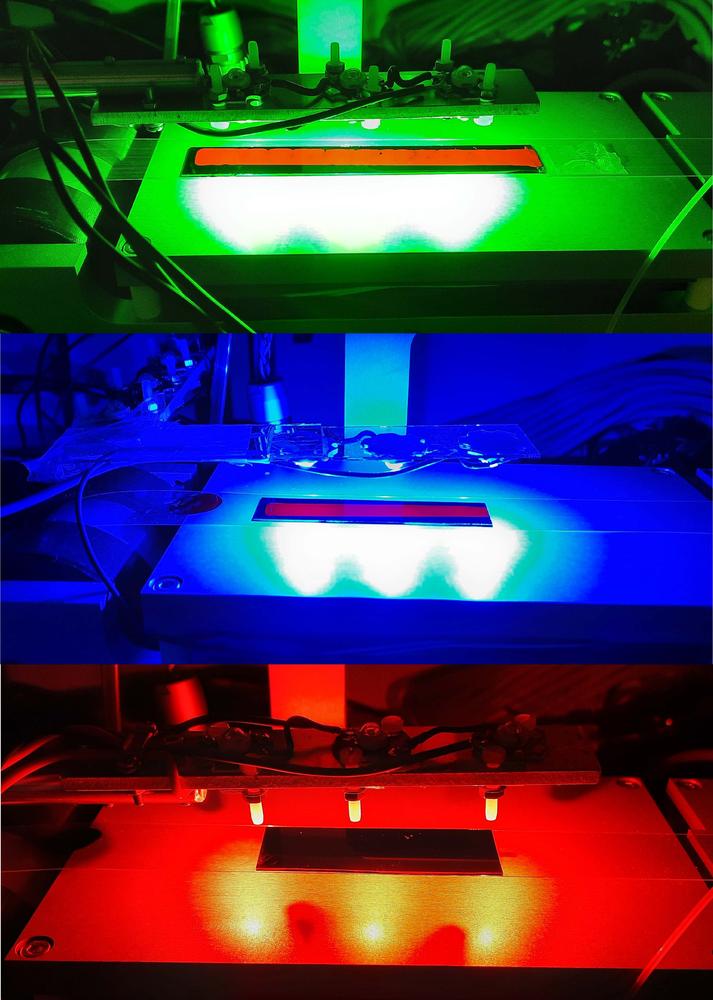| Jan 17, 2023 |
| (Nanowerk News) At DESY´s brilliant X-ray source PETRA III, an international research team was able to observe in real time the influence that ambient light has on the production of organic semiconductors. The group, led by researchers from the Technical University of Denmark, combined different observation techniques and found that the semiconductor behaves substantially different during the coating process in red light or darkness, compared with light below a certain wavelength, as they write in the latest issue of Advanced Functional Materials (“Manipulating Organic Semiconductor Morphology with Visible Light”).
|
|
The experiments show a way to control the morphology of organic semiconductor devices during their fabrication using visible light.
|
 |
| In their experiments, the research team illuminated the wet films of P3HT solution applied to silicon wafers with green (top), blue (middle) or red LED light as they dried. (Image: Michael Korning Sørensen)
|
|
Organic semiconductors have the potential to replace their silicon predecessors in many applications. Organic LEDs (OLEDs) are already used as standard in monitors, and organic solar cells already have efficiencies similar to their inorganic counterparts. However, the manufacturing processes of solar cells, for example, that achieve such efficiencies are not yet compatible with mass production. Therefore, their further research and development are close to the top of the researchers´ agenda.
|
|
The Danish-German research team has now taken a closer look at the manufacturing process of a typical organic semiconductor (poly(3-hexylthiophene) or P3HT) used for flexible solar cells and organic electronics. In this process, the photoactive material is printed directly on a polymer film that can be moved under the print head as if on a conveyor belt. This process, known as roll-to-roll printing, is industrially applicable and enables an increase in productivity while reducing costs.
|
|
During the production of the active layer, the scientists excited the semiconductor polymer by shining visible light of different wavelengths onto it. In doing so, the team was able to observe in real time how the coloured illumination changed the formation of the semiconducting domains of the polymer: In solution, as seen at the PETRA III beam line P03, without illumination or under red light, the polymer chains quickly start to aggregate and form ordered domains. When illuminated under green or blue light, the more rigid polymer chains, excited by the light, are prevented from aggregating, even to the extent of breaking up existing aggregates.
|
|
The observations during roll-to-roll printing confirmed this, with the end result being less ordered and differently textured films when coating the active layer under green or blue light. This has an impact on the conducting properties of the material, seen as changes in charge mobility along different directions in the film.
|
|
The researchers explain the result by the fact that green light or light with even shorter wavelength excites the polymer in such a way that it interacts differently with the solvent during production, preventing if from curling up with itself and form ordered domains through the drying processes. This hypothesis is supported by theoretical simulations and by measurements with neutrons and terahertz spectroscopy.
|
|
“Our result shows a comprehensive picture of the production of the organic semiconductor, from the demonstration of the application of our method to a fundamental understanding of the changes in morphology and physical properties caused by the excitation of P3HT during deposition,” says the leader of the research Jens Wenzel Andreasen from the Technical University of Denmark.
|
|
“We can show that visible light causes organic semiconductors in an excited state to prefer different arrangements of the molecules, and thus the morphology becomes manipulable,” adds Matthias Schwartzkopf from the PETRA III beamline P03, which specializes in tracking live coating processes of organic electronics. “In future, this could play a role in the processing of solar cells and organic electronics. For example, processing using red light similar to traditional photo processing might be recommended, depending on the behaviour of the materials.”
|
- SEO Powered Content & PR Distribution. Get Amplified Today.
- Platoblockchain. Web3 Metaverse Intelligence. Knowledge Amplified. Access Here.
- Source: https://www.nanowerk.com/nanotechnology-news2/newsid=62184.php



